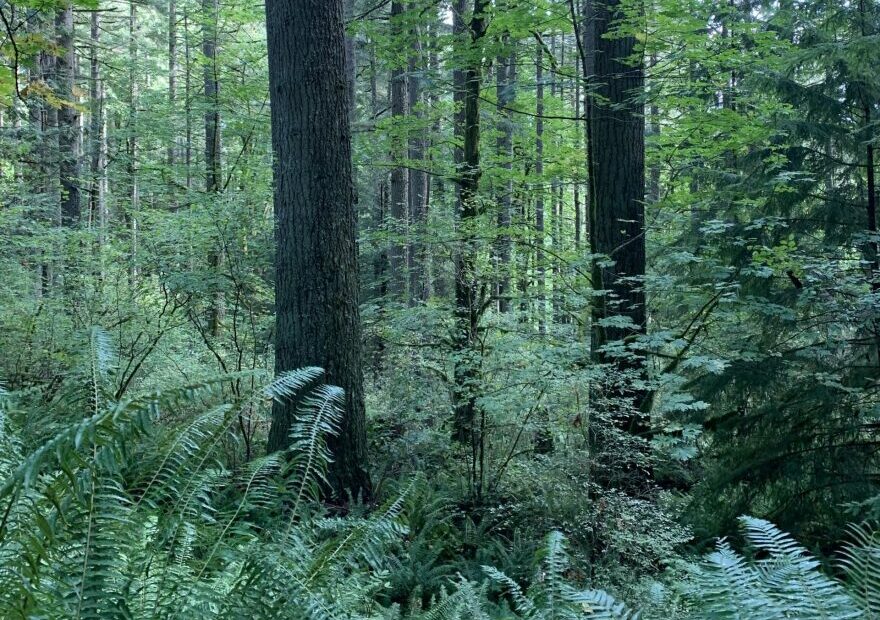
Reactions from PNW on nationwide directive to protect old-growth forests
Listen
(Runtime 1:03)
Read
The United States Forest Service, under the directive of the United States Department of Agriculture, has announced plans to apply consistent standards to the conservation, restoration and maintenance of old-growth across the country’s national forests.
It’s a first of its kind standard that many say is necessary, given threats from climate change and varied management practices.
“I would say it’s historic,” said Josh Hicks, director of conservation campaigns with The Wilderness Society.
The proposed changes to 128 management plans for units of the National Forest System, seek to protect and steward trees defined as 150-years and older; like the majestic giant Sequoias and Douglas Firs that Western settlers once sought to log as prime lumber. Some environmentalists have fought to conserve those trees for their beauty and ecosystem benefits.
With the goal of conservation, Hicks said the amendments would work to conserve and restore old-growth landscape with prescribed burns and mechanical thinning. The amendments will mean old-growth cannot be harvested for purely economic reasons.
“It’s great to finally see it. The urgency is real,” said Susan Jane Brown, principal and chief legal counsel for the environmental law firm Silvix Resources in Oregon.
Protection of old-growth on federal lands is already happening in the Pacific Northwest — it’s not standard practice anymore for the Forest Service to be harvesting from those stands. The 1994 Northwest Forest Plan protects much of the remaining old-growth across Washington, Oregon and California.
The national amendment will make sure that the strategy to conserve old-growth, steward and protect it from threats such as wildfires and insects, is consistent across the nation.
“It would harmonize protections for old-growth forests across the country and create a uniform conservation approach for old-growth forests,” Brown said.
Prior to this amendment, the administration completed an inventory of old-growth and mature forests on federal lands, which identified an estimated 24.7 million acres of old-growth across the National Forest System lands.
With much of the remaining old-growth already protected in the Northwest, environmentalists are looking to the next generation of trees. Brown said she feels there is still work to be done when it comes to protecting mature forests; stands of trees not old enough to be classified as old-growth, but getting there.
“If you want old-growth forests, you need to propagate mature forests so that those forests will age into that oldest class,” Brown said. She also said there needs to be proper stewardship of mature forests.
The announced amendment doesn’t come with any funding but about $5 billion was allocated for the USFS in the Bipartisan Infrastructure Law, $3 billion of which is meant for wildfire risk reduction and restoring ecosystems.
“These billions of dollars could be used to conduct the restoration treatments to manage ecosystems and make them more resilient to wildfire, including conservation of old-growth,” Hicks said.
Also getting an update is the Northwest Forest Plan. Those amendments have yet to be drafted.
Brown said she hopes amendments to the Northwest Forest Plan recognize the diversity between forest types. From the Olympic National Forest, a verdant rainforest, to the Okanogan-Wenatchee National Forest, where dry landscapes burn more frequently, the forests in the Pacific Northwest vary a lot.
As the Northwest Forest Plan amendment is drafted, ensuring that forest variability is accounted for, is crucial, Brown said.
“There is still a need for a viable timber industry in our region,” Brown said. “And nationally, if we want to have healthy forests that are restored, we need a workforce and an industry to do that restoration.”
Timber harvests on federal land in Washington are already often a byproduct of forest restoration efforts, said Nick Smith, the public affairs director for the American Forest Resource Council.
“In Washington state, a lot of the focus on federal lands is forest restoration and, enabling forests to not only to sustain old-growth characteristics but also wildlife habitat for the owls and other species,” Smith said.
Smith said his concern with the amendments is it creates more policy that will be a lack of workforce to do the forest restoration work being proposed. Reps. Lori Chavez-DeRemer (OR-05) and Marie Gluesenkamp Perez (WA-03) introduced the Jobs in the Woods act last year, meant to create a grant program for forestry workforce development to address shortages.
The nationwide forest plan amendment is open for public comment. Amendments would go into effect in early 2025.
















